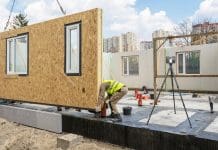Previously viewed as “clever but pricey”, modular construction is now quickly gaining momentum, especially on major projects where designs are detailed and space on site is tight
Modular construction involves various methods and processes (generally heavily automated) which take the construction of a project away from the traditional construction site. Instead, they place it in a “manufacturing system” where components are constructed and assembled offsite, then delivered “ready-made” for installation at the site.
Energy and Infrastructure projects are particularly engaging with modular construction procurement methods, with support from industry project giants such as HS2 installing modular bridges and HPC erecting a reactor building in modular segments. In an increasingly complex and competitive market, a method of construction that offers quality precision and long-term savings is understandably a “no-brainer”. Increased support and engagement at this level are paving the way for more cost-effective usage across a number of wider industry sectors such as education, hotels, private residential and social housing.
Clarke Willmott’s construction team has first-hand experience of modular construction being utilised for workforce accommodation at Hinkley Point C Power Station. There are clear benefits in manufacturing “modules” (sometimes known as “pods”) offsite, using the same materials and designs as would be used in more traditional construction, but often in far less time. This concept is particularly advantageous when developing fairly commoditised footprints within a project, as will often be the case with complex major projects. Taking the production offsite enables the developer to minimise some of the risks that would otherwise be “at large” (and the subject of lengthy contract or tender negotiations), such as bad weather and site conditions. It also provides the backdrop for more robust, easier-to-manage procurement and quality control processes in a safe environment.
Modular benefits
Modular construction has obvious benefits when it comes to testing. Taking the construction process away from site, to a climate-controlled, secure facility allows the testing process to be as vigorous and/or as repetitive as required, without needing to factor in site-specific anomalies traditionally present on-site. While some testing and co-ordination will be required at site as the project nears completion, the modular process should reduce last minute surprises (and extension of time claims) where it transpires that things do not quite work as expected.
With a growing focus on sustainability, modular construction also scores “green” points, with manufacturing facilities better able to deliver environmentally-friendly processes than a traditional site. Facilities can be specifically designed to be as sustainable as possible – this is not true of a traditional site, where things have to be taken as found.
There has been nervousness in the market around the quality of modular products, with early critics querying how a “production line” approach could deliver the same quality as something built under developing conditions on-site. However, this mind-set is now emerging as a misconception, thanks to the continuous improvement of technology informing design and manufacturing. Major projects are of course at the forefront of this technology, designing highly detailed and complex elements. As such, they are the perfect arena for modular build. Further, as technology advances across the whole construction industry even the smaller players can accurately design and programme to ever more achievable tolerances, making modular build accessible to them also.
Cost
This inevitably comes at a price. Developers wanting to turn to long term modular construction will often need significant upfront investment to research appropriate technology and designers. However, if this investment process is well managed, the result can be a streamlined, highly technical process that is fully bespoke.
The flow of funds on a modular construction project is likely to see a move from valuation-based payments to milestone payments (as would be the “norm” in major projects). Modular construction often requires large orders being placed at the outset, requiring materials and designs to be available at the early stages of a project. While this should level out as the project gets underway, there is inevitable unease around high front-ended costs in an industry not used to these. Requests for advance payments are likely to grow in frequency as the market embraces modular methods, with contractors looking to lock in funds to get production underway. Construction contracts will need careful consideration to allay developer concerns about a change in procurement structure from one they may have used for decades. Interested third parties may also need to be guided through the process in detail to better understand its nuances and longer-term benefits.
To assist developers in benefitting from process innovations and economies of scale longer-term (and to assist emerging modular construction facilities), there needs to be a suitably large scale of modular construction projects. Major projects are ahead of the market here. There is increasing appetite for more wide-spread use of this model in education, hotels, accommodation and housing developments but some markets and locations remain behind the curve.
If a developer takes the ultimate step in embracing modular construction and builds its own fabrication facility, an initial and substantial outlay is required, but a developer can then develop and refine its own particular product and methodology of construction, allowing for quicker completion of future projects. Labour may be cheaper if this model is followed as many methods of modular construction utilise semi-skilled labour for the majority of the processes, with the skilled (more expensive and more scarce) labour required only towards the end of the project; unlike traditional construction which requires a constant presence of skilled labour.
Is the investment worth it?
In an evolving construction industry which has a backdrop of market uncertainties and a recognised skills shortage looming, it seems inevitable that more developers will pursue more control and use modular construction to keep project delivery efficient and sustainable. These are often key markers of success in major projects in the public eye.
Zoe Stollard

Partner in the construction team
zoe.stollard@clarkewillmott.com
Twitter: @ClarkeWillmott
LinkedIn: Clarke Willmott LLP
















